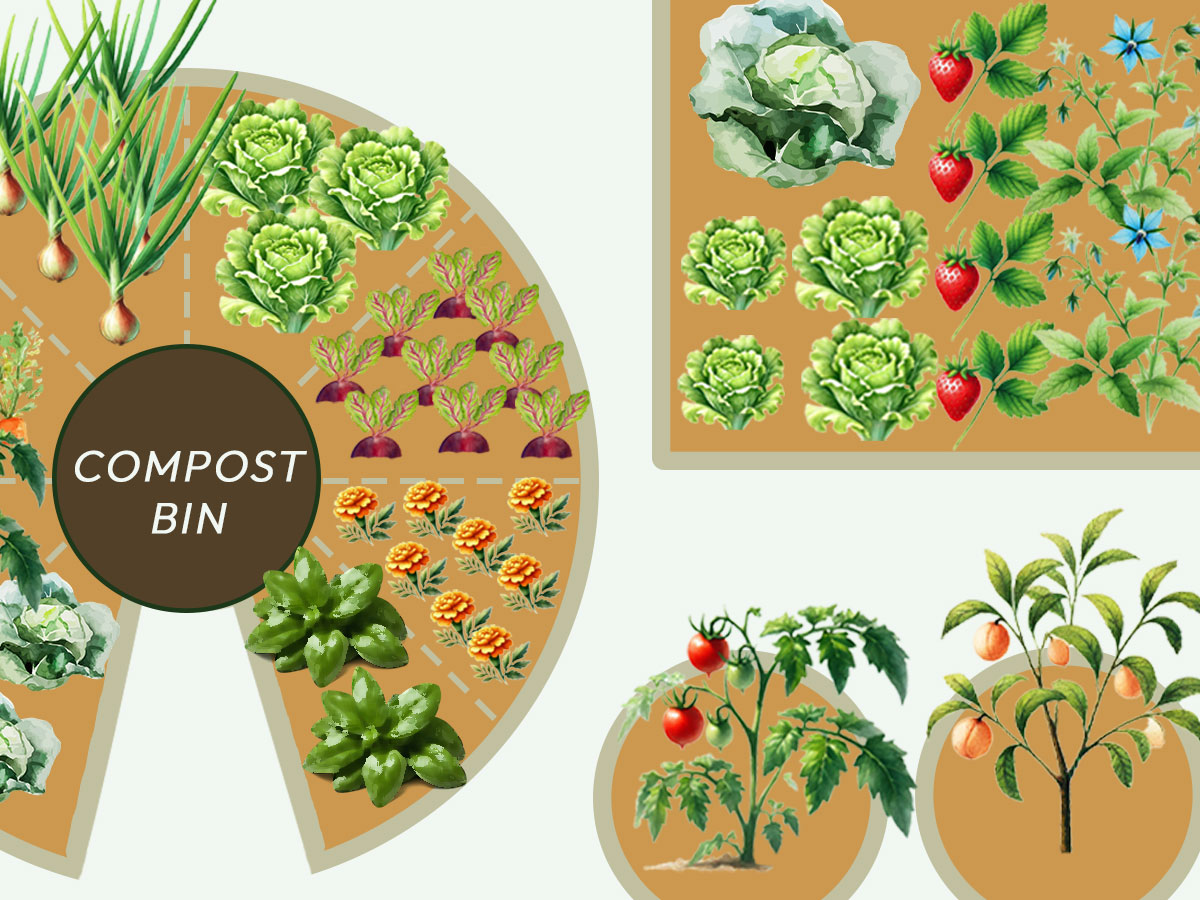The 5 Best Planting Layouts for Small Gardens
September, 2024 |In small gardens, we can often feel limited by how many plants we can grow. Creating a layout that allows you to fit in veggies alongside beautiful shrubs and flowers can be a struggle.
Luckily there are plenty of creative and effective planting techniques that can help you make the most out of a small garden space!
Whether you’re a seasoned gardener or a green-thumbed newbie, these tried and tested methods will inspire you to transform your small space into a productive and beautiful oasis.
5 Ingenious Planting Techniques for Small Gardens
So, let’s dive into five fantastic planting techniques to inspire your own mini garden space. For each technique, I’ve added a diagram and included some planting examples too!
1. Square Foot Gardening
Square foot gardening can be a real game-changer for small spaces. This technique involves dividing your garden (e.g. a DIY raised bed) into small, manageable squares — typically 1-foot by 1-foot sections.
Each square is dedicated to a different type of vegetable, herb, or flower. And there’s a rough guide to how many of each plant you can fit into each. For example, larger plants like tomatoes or melons fit into one square, whereas most people recommend about 4 lettuce plants or marigolds, and up to 16 green onions or radishes per square.
Related Read | 12 Tasty Mini Melon Varieties for a Small Garden
The beauty of this method is that it maximizes space, ensures efficient use of soil, and makes it easy to plan and manage your garden. It’s perfect for growing a variety of crops without feeling overwhelmed!
To get started, build a raised bed and divide it into grid squares using string or wooden dividers. Each square can be planted with a specific crop based on its space needs.
This technique helps keep your garden organized and can increase your yield in a compact area.
Best for: Any small garden, from containers to raised beds.

2. Keyhole Gardening
Keyhole gardening is another ingenious method that’s ideal for small gardens. Imagine a circular raised bed with a keyhole-shaped path leading to the center — this design allows you to access every part of your garden with ease. The keyhole shape not only provides efficient space utilization but also incorporates composting directly into the bed.
In a keyhole garden, the central composting area enriches the soil as it decomposes, reducing the need for additional fertilizers. Simply build a raised bed with a keyhole-shaped access point, and place a composting basket or pile in the center.
Fill the bed with a mix of soil and compostable materials. As you plant your vegetables around the bed, the nutrients from the compost will help them thrive. It’s a sustainable and space-saving solution!
Best for: Gardens with at least 8×8 feet of space.

3. Container Gardening
Container gardening is the most flexible and versatile gardening method for small gardens. By using pots, tubs, or other containers, you can grow a variety of vegetables, herbs, and flowers in even the tiniest of spaces.
Containers can be placed on patios, balconies, or windowsills, making it easy to create a vibrant garden wherever you have space.
Related Read | 11 Vegetables You Can Grow Indoors on a Windowsill
Choose containers that suit the plants you want to grow — deep pots for root vegetables like carrots, and shallow ones for herbs. Ensure your containers have good drainage, and use high-quality potting soil to help your plants flourish.
With container gardening, you can move plants around to catch the sun or protect them from harsh weather, offering flexibility and complete control over your garden.
Best for: Patios, balconies, and gardens where you can’t dig up the soil.

4. Vertical Gardening
Vertical gardening is perfect for maximizing space by growing plants upward rather than outward! Utilize trellises, wall-mounted planters, or hanging pots to create a lush, green vertical garden. This technique works particularly well for climbing plants like clematis and star jasmine and fruits and vegetables that grow vertically.
Related Read | How to Create a Vertical Vegetable Garden
You can build or buy vertical planters and trellises to fit your garden’s needs. Install them against walls, fences, or even as standalone structures.
Vertical gardening not only saves ground space but also adds visual interest and can create a striking focal point in your garden. Plus, it makes harvesting easier and keeps vegetables off the ground, reducing pests and diseases.
Best for: Any small garden, but especially very tiny spaces like balconies or courtyard gardens.

5. French Intensive Gardening
French intensive gardening (sometimes called raised bed gardening) is a wonderfully efficient and sustainable way to make the most of a small garden space. This method, which was used in France during the 19th century, is all about getting the highest yield from your garden while nurturing the soil and environment.
Here’s what makes it special…
- Raised Beds: This method usually uses raised beds to improve soil quality and water retention. Plus, depending on their height, they can be easier to manage!
- Close Plant Spacing: Plants are nestled closely together with barely any empty soil to maximize space. It can also conserve moisture and keep weeds at bay. This way, you get a lot more from every square foot.
- Companion Planting: Some plants are often paired together to reduce pests (trap cropping), improve soil health and even boost flavour!
- Crop rotation: Growing different crops in the same spot each season to keep the soil healthy, reduce pests and keep your garden producing year round!
- Intercropping: the practice of growing different crops together in the same space to maximize garden efficiency e.g. shallow and deep-rooted crops next to each other.
- Succession Planting (Relay Cropping): the practice of planting crops in a staggered timeline to ensure continuous harvest throughout the growing season.
French intensive gardening is more than just a gardening technique; it’s considered a more sustainable way to grow a beautiful, productive garden while staying in harmony with nature. It leans into organic practices like composting, mulching, and using natural fertilizers.
Instead of a bed filled with only vegetables, you may instead plant a tomato plant surrounded by marigolds, and a borage plant next to a group of strawberry plants. It creates a more natural look compared to row after row of the same vegetable.
Whether you have a small backyard or just a few square feet to work with, this method can help you cultivate a lush, thriving garden that rewards you all year round.
Best for: Gardens with raised beds where plants can be planted close together.

Which planting layout will you use?
With these five garden planting layouts, you can transform your small garden into a thriving and amazingly productive green space!
Whether you opt for the flexibility of container gardening or the innovative keyhole gardening with its built-in compost bin, there’s a method to suit the needs of any small outdoor space.





